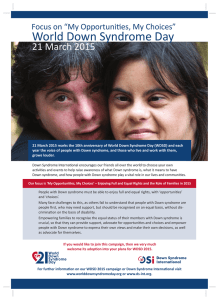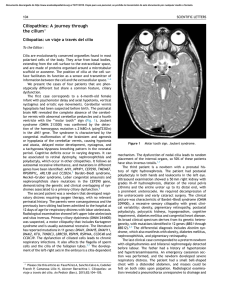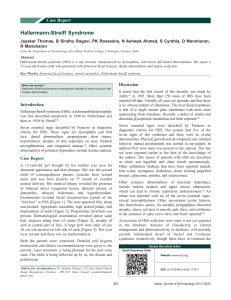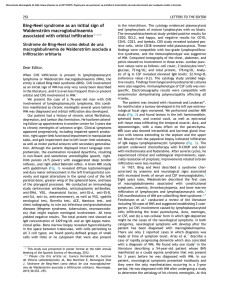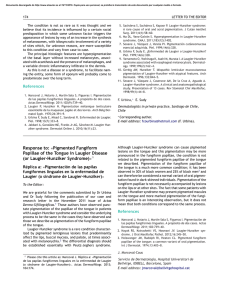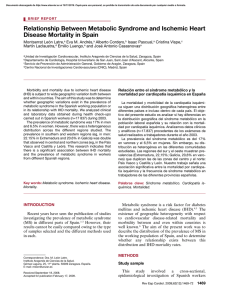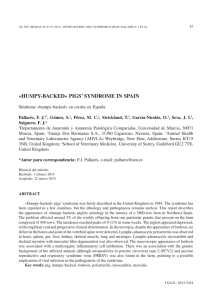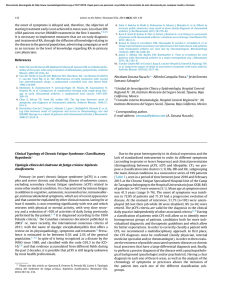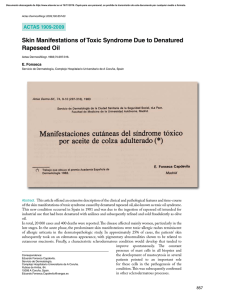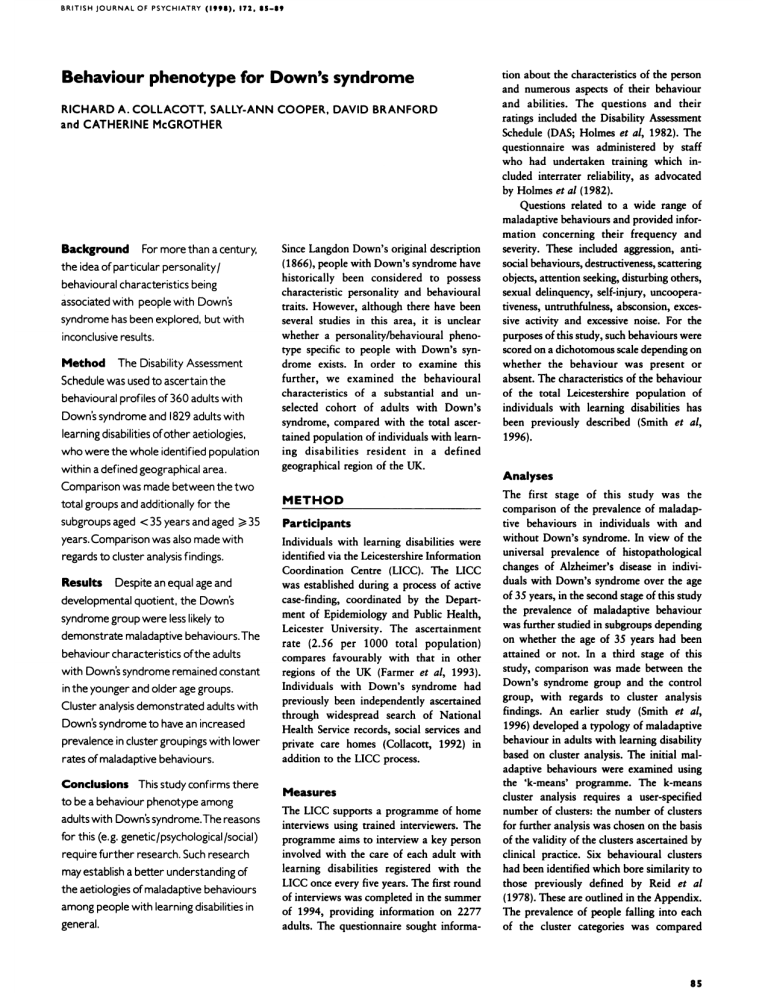
BRITISH JOURNAL OF PSYCHIATRY (1998), 172, 85-89 Behaviour phenotype for Down's syndrome RICHARD A. COLLACOTT, and CATHERINE Background SALLY-ANN For more than a century, the idea of particular personality/ behavioural characteristics being associated with people with Down's syndrome has been explored, but with inconclusive results. Method COOPER, DAVID BRANFORD McGROTHER The Disability Assessment Schedule was used to ascertain the behavioural profiles of 360 adults with Down's syndrome and 1829 adults with learning disabilities of other aetiologies, who were the whole identified population within a defined geographical area. Since Langdon Down's original description (1866), people with Down's syndrome have historically been considered to possess characteristic personality and behavioural traits. However, although there have been several studies in this area, it is unclear whether a personality/behavioural pheno type specific to people with Down's syn drome exists. In order to examine this further, we examined the behavioural characteristics of a substantial and unselected cohort of adults with Down's syndrome, compared with the total ascer tained population of individuals with learn ing disabilities resident in a defined geographical region of the UK. METHOD subgroups aged < 35 years and aged > 35 Participants years. Comparison was also made with Individuals with learning disabilities were identified via the Leicestershire Information Coordination Centre (LICC). The LICC was established during a process of active case-finding, coordinated by the Depart regards to cluster analysisfindings. Results Despite an equal ageand developmental quotient, the Down's syndrome group were lesslikely to demonstrate maladaptive behaviours.The behaviour characteristics of the adults with Down's syndrome remained constant in the younger and older age groups. Cluster analysisdemonstrated adults with Down's syndrome to have an increased prevalence in cluster groupings with lower rates of maladaptive behaviours. Conclusions This studyconfirms there to be a behaviour phenotype among adults with Down's syndrome.The reasons for this (e.g. genetic/psychological/social) require further research. Such research may establish a better understanding of the aetiologies of maladaptive behaviours among people with learning disabilities in general. tiveness, untruthfulness, absconsion, exces sive activity and excessive noise. For the purposes of this study, such behaviours were scored on a dichotomous scale depending on whether the behaviour was present or absent. The characteristics of the behaviour of the total Leicestershire population of individuals with learning disabilities has been previously described (Smith et al, 1996). Analyses Comparison was made between the two total groups and additionally for the tion about the characteristics of the person and numerous aspects of their behaviour and abilities. The questions and their ratings included the Disability Assessment Schedule (DAS; Holmes et al, 1982). The questionnaire was administered by staff who had undertaken training which in cluded interrater reliability, as advocated by Holmes et al (1982). Questions related to a wide range of maladaptive behaviours and provided infor mation concerning their frequency and severity. These included aggression, anti social behaviours, destructiveness, scattering objects, attention seeking, disturbing others, sexual delinquency, self-injury, uncoopera- ment of Epidemiology and Public Health, Leicester University. The ascertainment rate (2.56 per 1000 total population) compares favourably with that in other regions of the UK (Farmer et al, 1993). Individuals with Down's syndrome had The first stage of this study was the comparison of the prevalence of maladap tive behaviours in individuals with and without Down's syndrome. In view of the universal prevalence of histopathological changes of Alzheimer's disease in indivi duals with Down's syndrome over the age of 35 years, in the second stage of this study the prevalence of maladaptive behaviour was further studied in subgroups depending on whether the age of 35 years had been attained or not. In a third stage of this study, comparison was made between the Down's syndrome group and the control previously been independently ascertained through widespread search of National Health Service records, social services and private care homes (Collacott, 1992) in addition to the LICC process. group, with regards to cluster analysis findings. An earlier study (Smith et al, 1996) developed a typology of maladaptive behaviour in adults with learning disability based on cluster analysis. The initial mal adaptive behaviours were examined using the 'k-means' programme. The k-means Measures cluster analysis requires The LICC supports a programme of home interviews using trained interviewers. The programme aims to interview a key person involved with the care of each adult with learning disabilities registered with the LICC once every five years. The first round of interviews was completed in the summer of 1994, providing information on 2277 adults. The questionnaire sought informa number of clusters: the number of clusters for further analysis was chosen on the basis of the validity of the clusters ascertained by clinical practice. Six behavioural clusters had been identified which bore similarity to those previously defined by Reid et al (1978). These are outlined in the Appendix. The prevalence of people falling into each of the cluster categories was compared a user-specified 85 COLLACOTT ET AL between those with and those without Down's syndrome. 13 behaviours examined, compared with those without Down's syndrome. The low er scores for the Down's syndrome group RESULTS were significantly different for 10 of the behaviours. For those with Down's syn Group characteristics drome aged >35 years the prevalence of maladaptive behaviours was lower for 12 of the 13 behaviours examined. However, for only seven behaviours was the differ ence in prevalence significant (Table 2). There was no significant difference in the prevalence of any of the 13 maladaptive Behavioural records were completed for 2189 (96%) of 2277 adult individuals with learning disabilities known to the LICC. Among the 2189 individuals, 360 (16.44%) had Down's syndrome, of whom 164 (45.56%) were aged <35 years and 196 (55.44%) were aged ^35 years. The mean age of those with Down's syndrome was 37.14 years (95% CI 35.99-38.30) and 37.84 years (95% CI 37.15-38.53) for those without Down's syndrome. The mean Table I developmental quotient was 29.39 (95% CI 28.25-30.54) for those with Down's syn between those with Down's syndrome aged < 35 years and those who were older. For individuals without Down's syndrome, the prevalence of nine types of maladaptive behaviour was significantly reduced in those who were older group compared with those aged < 35 years. The maladaptive behaviours in non-Down's syndrome individual, the pre valence of which did not change with age, included aggression, antisocial behaviour, sexual delinquency and untruthfulness. Prevalence of maladaptive behaviours Down's syndrome (n=360) Maladaptive behaviour drome and 30.33 (95% CI 29.67-30.99) for those without Down's syndrome. behaviours Non-Down's syndrome (n=l829) (31)***4.72(17)**8.89 AggressionAntisocial (444)9.24(169)18.97(347)14.76 behaviourProperty For the total group there were signifi cant differences in the prevalence of maladaptive behaviour between the two groups (Table 1). People with Down's (32)***9.72 destructionDisturbing (35)*3.89(14)«12.22(44)***1.67(6)7.22 (270)8.80(161)27.67 nightScattering others at objectsAttention-seekingSexual syndrome had lower rates of each of the 13 maladaptive behaviours examined, and for 11 behaviours this lower prevalence was significant. (506)3.39 delinquencySelf-injuryUncooperativenessUntruthfulnessExcessive (26)***25.39 (62)19.52(357)31.22(571)11.21 (95)6.94 (25)*3.33(12)***5.00(18)**9.17(33)***24.28 (205)16.62(304)10.66(195)16.73(306) Age effects activityAbsconsionExcessive The second stage of the study showed that for adults aged <35 years with Down's noise8.61 syndrome, the prevalence of maladaptive behaviours was again lower in each of the Table 2 *P<0.05. **P<O.OI,«*P<O.OOI. Prevalence of maladaptive behaviours for those aged < 35 years those aged Maladaptive behaviour 35 years Age ~^35 years Age < 35 years syndrome (n=l64) syndrome (n=93l) %(n)8.54(14)***4.27(7)9.15(15)***9.76(16)*2.44 X(n)25.56 AggressionAntisocial syndrome (n=l96) (74)22.45 destructionDisturbing (209)17.51 nightScattering others at objectsAttention-seekingSexual (206)10.38(95)15.08(138)11.69(107)6 (17)*9.69(19)5.10(10)12.76 (163)10.85(101)29.54 (4)***11.59(19)***1.83(3)9.76(16)***25.00(41)**6.10(10)4.27 (275)2.69 delinquencySelf-injuryUncooperativenessUntruthfulnessExcessive (n=9IS) %(n)8.67(17)***5.10(10)*8.67 %(n)22.51 (238)7.95 behaviourProperty syndrome (55)25.25(231)4.04 1 (25)***1.53(3)5.10(10)***27.55 (25)23.31 (37)15.30(140)26.45 (217)35.34 (329)10.42(97)19.12(178)12.46(116)18.80(175)Down's (54)7.65(15)2.55 (7)***4.88 activityAbsconsionExcessive (8)**10.37(17)**Non-Down's (79)14.34(131)versus noise*P<0.05, **P<O.OI,"*P<O.OOI,Down'snon-Down's 8« syndrome of same age group. (242)11.80(108)13.77(126)8.63 (5)***5.10(1)8.16(16)*Non-Down's Behavioural clusters Age effect and behavioural clusters populations, but also for the under 35-year- The third stage of the study examined the total group with Down's syndrome. The Table 3 also shows the prevalence for each cluster group for the adults with Down's pattern of membership of behavioural clusters was found to be significantly different from that in those people with out Down's syndrome (x2=69.73, d.f.=5, syndrome and the adults with learning disabilities of other aetiologies, dependent upon whether they are aged < 35 years or >35 years. For the younger group, a significant difference was noted in the number of people forming the membership of each group, between those with and without Down's syndrome. For those aged olds and the two groups aged >35 years. The difference was more marked in the younger adults. Differences in the propor tion of people in each of the previously defined behaviour clusters were also found. People with Down's syndrome were more P < 0.001). In particular, clusters 1 and 2 consisted of 8.9 and 8.5%, respectively, of the group without Down's syndrome, but only 2.2 and 4.4%, respectively, of the group with Down's syndrome. Clus ters 1 and 2 include individuals with high levels of aggressive and destructive behav iours, including self-injury. These behav ioural clusters also include described as attention-seeking, individuals overactive, noisy and uncooperative. Within these clusters high rates of autistic symptoms, including difficulties with social inter action, empathy, repetitive speech and stereotypy are present. In addition, clus ters 4 and 6 consisted of 15.1 and 6.2%, respectively, of the group without Down's of the six groups. No significant difference is found for groups 2 and 4 (although the proportion of people in both these groups is higher in the non-Down's syndrome adults than in the Down's syndrome adults). Study design includes individuals whose major behav ioural difficulty was that of attentionseeking. Cluster 6 was characterised by high rates of aggressive, destructive and antisocial behaviours. On the other hand, cluster 3 comprised only 10.0% of those without Down's syndrome but over 17% of those with Down's syndrome. Cluster 3 included a group generally considered to be uncooperative but who demonstrated few other maladaptive behaviours. Cluster 5 - those without significant behavioural difficulties - comprised only 51.3% of those without Down's syndrome, but over 65% of those with Down's syndrome (Table 3). syndrome who reach the age of 35 years. However, the changes between the Down's syndrome and control subjects in the older versus younger age groups appear to be due to changes in the behavioural profiles of control subjects with age, rather than changes in Down's syndrome subjects with DISCUSSION syndrome, but only 8.6 and 1.7% of the group with Down's syndrome. Cluster 4 Table 3 >35 years, differences in the numbers in each cluster group between those with and without Down's syndrome are seen in four likely to belong to clusters 3 and 5 than were the control individuals. Differences were found between both the two groups of younger adults and the two groups aged >35 years. However, the differences were more marked for the younger adults. The reason for splitting the groups for comparison on the basis of age was the presence of histopathological changes of Alzheimer's disease in people with Down's This study has the advantage of being a large, population-based study. All adults identified to have Down's syndrome and identified to have learning disabilities of other causes within a defined geographical area were included. This includes indivi duals living both in the community and in National Health Service accommodation. The identification of such subjects followed a prolonged period of active case-finding. The instrument used to rate behaviour with the informant is robust, and has been previously validated (Holmes et al, 1982). Adults with Down's syndrome were found to have lower prevalences of mal adaptive behaviours compared with control adults with learning disabilities of other aetiologies. This was true for the two whole age. The behavioural characteristics of the adults with Down's syndrome remained remarkably constant in the two age bands. Comparison of findings with previous studies Langdon Down (1866) commented upon 'powers of imitation', 'mimicry' and a "humerous and lively sense of the ridicu lous", and in a later paper 'obstinacy' and 'amiability' (Down, 1877). Fraser & Mitchell (1876) istics of being good tempered chievous', "but also described character 'cheerful', "affectionate, and easily amused", 'mis it is very rare to find him guilty of bad temper or any of the vices or bad habits which characterise so many of Membership of behavioural clusters Cluster Total population Aged < 35 years Down's syndrome Non-Down's syndrome Down's syndrome Non-Down's syndrome o/ /_\ o/ /_.\ /b (n) 1234562.22 Aged > 35 years Tb(n) Down's syndrome Non-Down's syndrome o//\ Tb(n) o//\ ?b(n) (8)***4.44(16)**17.22(62)***8.61 (5)***4.27 (163)8.47(155)10.00(183)15.15(277)51.29(938)6.18(113)3.05 o//\ Ä (n) (60)6.42 (7)*17.07 (9)17.35 (58)9.18(83)14.27(129)56.96(515)6.53 (28)*7.32(12)**67.07(110)***1.22(2)*11.14(103)10.49(97)10.81 (34)***9.69(19)64.80(127)*2.04 (100)16.00(148)45.72 (31)***65.84(237)***1.67(6)***8.91 (423)5.84 (54)1.53(3)**4.59 *P<0.05, **P<O.OI, *"P<0.001, (4)*6.64 (59) versus non-Down's syndrome in same agegroup. • 7 the ordinary defectives". Fraser & Mitchell (1876) also commented on traits of mimi cry and musicality. Brousseau oc Brainerd (1928) studied 40 people with Down's syndrome, and concluded them to be good-natured, cheerful, affectionate and docile, and seldom ill-tempered or destruc tive. However, Rollins (1946) in his study of 73 people with Down's syndrome, found 60% to have a history behaviours, which included haviours. Only 44% of the conformed to the stereotype. suggested that people with of abnormal antisocial be present group Engler (1949) Down's syn drome fell into three groups, only one of which coincided with the stereotype. The other two groups consisted of people who were either dull and listless, or excessively pugnacious and spiteful. Blaketer-Simmonds (1953) compared the case notes of 140 people with Down's syndrome with 100 people with learning disabilities of other aetiologies. The two groups were similar for most characteristics, and dif fered only with regards to increased mischievousness, solitariness, and reduced docility among the Down's syndrome group. He further studied 60 people with Down's syndrome and 300 people with learning disabilities of other aetiologies, using an informant-rated questionnaire of personality traits, and found no differences between the two groups. Moore et al (1968) studied 536 people with Down's syndrome (average age 21 years) and matched controls. They were less likely to show hyperactivity, aggressive, destructive, self-injurious, restless or noisy behaviours. A larger group of 2606 people with Down's syndrome, with the same mean age, also showed differences from controls, with higher proportions of so cially adaptive, socially competent behav iour (Johnson & Abelson, 1969). Most other studies of the personality and behav iour of people with Down's syndrome have focused exclusively on children (Bridges oc Cicchetti, 1982; Gibbs & Thorpe, 1983; Gath oc Gumley, 1986; Rodgers, 1987; Pueschel et al, 1991), with conflicting results. Methodological differences from previous studies Several of the previous studies exploring this area have used children as subjects. Childhood is a time when personality is shaped and develops, and so results from findings of children cannot be extrapolated 88 to infer that the same is true for adults. This highlights problems in those studies which have grouped together both children and adults. Of those studies which have exam ined the characteristics of adults only, conflicting results have been found with regard to whether there is a characteristic behaviour profile in Down's syndrome. This may relate in part to the different methodologies employed. Some studies did not include a reference control group (Brousseau ÖCBrainerd, 1928; Rollins, 1946), others used case notes as the source of information or informant-rated ques tionnaires (Blaketer-Simmonds, 1953). Of the larger studies of adults which employed the use of a control group, contrary results were found. Blaketer-Simmonds (1953) found no differences between the Down's syndrome and non-Down's syndrome groups, whereas behavioural differences were found in two of the studies which grouped children and adults together (Moore et al, 1968; Johnson oc Abelson, 1969). Despite this background of conflicting results, the present results contribute further to the concept of there being a behaviour phenotype associated with Down's syndrome. The study gives some support to the original comments of Fraser Se Mitchell (1876) regarding the character istics of people with Down's syndrome. schizophrenia (Collacott et al, 1992). Over the age of 35 years many people with Down's syndrome have clinical dementia. This may account for the fact that no statistically significant difference is seen between people aged <35 years compared with those aged >35 years with Down's syndrome, whereas among those without Down's syndrome (fewer of whom will have dementia) the prevalence of nine types of maladaptive behaviours were signifi cantly reduced in the older group. ACKNOWLEDGEMENTS The authors acknowledge the assistance of the Infor mation Liaison Officers of the LICC in obtaining the original data, and Mrs L McManus for interpreting the original manuscript. APPENDIX Summary of cluster characteristics Ouster /. A wide range of maladaptive behaviours. More than half had aggressive and destructive behaviour, including self-injury. Two-thirds were de scribed as 'attention-seeking'. Most were excessively active, noisy and uncooperative. Nearly half tended to abscond. Associated behaviours included in creased prevalence of continuous eating or drinking, pica, hoarding rubbish, inappropriate sexual behav iours, faecal smearing, spitting, swearing, tantrums and self-induced vomiting. People in this cluster had significantly more autistic symptoms than the total population, were younger and of lower develop Possible explanation of results There are many conceivable reasons why people with Down's syndrome may have reduced rates of maladaptive behaviours compared with people with learning dis abilities of other aetiologies. The answer may lie at a genetic level: Down's syndrome is associated with structural and functional brain abnormalities (e.g. reduced levels of serotonin). Differences in the age structure, and range and central tendency of develop mental quotient, were not found between the Down's syndrome and non-Down's syndrome groups, and so do not account for differences found in the distribution and prevalences of maladaptive behaviours. Psychological and social factors may alternatively or additionally contribute to lower rates of maladaptive behaviours. Previous research has demonstrated that Down's syndrome is associated with a psychiatric phenotype, including predispo sition to dementia (Oliver oc Holland, 1986) and depression (Collacott et al, 1992), but a relative protection from mental quotient, and a higher proportion were male. A significantly higher proportion of individuals had epilepsy. Cluster 2. Most individuals in this cluster had ag gressive and destructive behaviours, and 90% showed self-injurious behaviour. They were unco operative and half were excessively noisy. Unlike cluster I. attention-seeking behaviour, disturbing others and absconsion were not frequent, and they were not excessively active. Associated behaviours included increased prevalence of continuous eating/ drinking, pica, inappropriate sexual behaviours, fae cal smearing, swearing, tantrums and self-induced vomiting. People in this group had significantly more autistic symptoms than did the total population, were younger and of lower developmental quotient and a higher proportion were male. The prevalence of epilepsy among people in this group was compar able with that in the total study population. Cluster 3. Members of this cluster had the charac teristic of uncooperativeness, but few other mal adaptive behaviours. Difficulties with social interactions were more common than in the total population, but there were no other associated mal adaptive features. Age, developmental quotient, gender ratio and seizure prevalence were similar to those in the total population. BEHAVIOUR PHENOTYPE FOR DOWN'S SYNDROME Cluster 4. Membership of this cluster was defined by the presence of attention-seeking behaviour, but few other maladaptive behaviours. Autistic symp CLINICAL toms, age, developmental quotient, gender ratio and seizure prevalence were similar to those in the •Adults with Down's syndrome have a lower prevalence of maladaptive behaviours, total population. compared with adults with learning disabilities of other causes. Cluster 5. IMPLICATIONS •Adults with Down's syndrome have a different Membership of this cluster was charac behavioural profile compared with terised by the very low prevalence of maladaptive behaviours and autistic symptoms. Age. gender ratio adults with learning disabilities of other causes. and seizure prevalence were similar to those in the total population, but the developmental quotient •These findings help to provide insights into the aetiology of maladaptive behaviours that might be explored in future research. was higher. LIMITATIONS Cluster 6. Behaviour characterised by high rates of aggression, destructive and antisocial behaviour, along with attention-seeking, uncooperative and un truthful •Maladaptive behaviours were recorded without reference to psychiatric diagnoses. •Shortage of previous research among adults with Down's syndrome with which to behaviour. Associated behaviours included higher rates of hoarding rubbish, inappropriate sex make comparisons. ual behaviours, faecal smearning, spitting, swearing and, especially, temper outbursts. The prevalence of autistic symptoms, gender ratio and seizure preva lence were similar to those in the total population. Members of this cluster were older and of higher developmental quotient compared with the total population. RICHARD A. COLLACOTT. FRCPsych,Western Isles Health Board; SALLY-ANN COOPER. MRCPsych, Rockingham Forest NHS Trust. Kettering, Northants; CATHERINE McGROTHER, MFPHM, Department DAVID BRANFORD. PhD. Frith Hospital. Leicester: of Epidemiology and Public Health, University of Leicester REFERENCES Correspondence Blaketer-Simmonds, D. A. (1953) An investigation into the supposed differences existing between other mentally defective subjects with regard to certain psychological 702-719. (First received 14April 1997, received 6 August 1997, accepted 26 August 1997) traits. Journal of Mental Science. 99, Bridges, F. A. & Cicchetti, D. (1982) Mothers' ratings K. & Brainerd, H. G. (1928) Mongolism: A Fraser, J. & Mitchell, A. (1876) Kalmucidiocy,journal of Mental Science.22.169-179. Mongolian Imbeciles. London: Bailliere, Tindall and Cox. Gath, A. It Gumley, D. (1986) Behaviourproblemsin retarded children with special reference to Down's Collacott, placement R. A. (1992) The effect of age and residential on adaptive behaviour of adults with Down's syndrome. British journal of Psychiatry,[49.156-161. syndrome. British Journal of Psychiatry. 161. 675-679. rates of psychiatric disorders in adults with Down's syndrome Gibbs, M. V. & Thorpe, J.G. (1983) Personality stereotype of non-institutionalised Down syndrome children. Americanjournal of Mental Deficiency,87. 602- compared to other mentally handicapped adults. British 605. , Cooper, S.-A., McGrother, C. (1992) Differential journal of Psychiatry. 161. 671-674. Down, J. H. L. (1866) Observations on an ethnic of idiots. In Clinical Lectures and Reports. Holmes, N., Shah, A. & Wing, L. (1982) The Disability Assessment Schedule: A brief screening device for use with the mentally retarded. PsychologicalMedicine. 12. 879-890. London: London Hospital. Reprinted in Payne. R. (1965) The centenary of 'mongolism'. journal of Mental Science. II, 89-92. (1877) Mental Afflictionsof Childhoodand Youth.London: Churchill. Engler, M. (1949) Mongolism.Baltimore,MD: Williams and Wilkins. Farmer, R., Ronde, J. & Sacks, B. (1993) Changing Servicesfor Peoplewith LearningDisabilities. London: Chapman and Hall. Oliver, C. & Holland, A. J. (1986) Down'ssyndrome and Alzheimer's disease:A review. Psychological /Medicine.16. 307-322. Study of the Physical and Mental Characteristics of classification Isles Hospital. Stornoway, Isle of Lewis, Scotland mongols and of the temperament characteristics of Down syndrome infants. Development Psychology. 18. 238-244. Brousseau, to: Dr Richard A.Collacott.Western HSI2AF Johnson,R. C. & Abelson, R. B. (1969) Intellectual, behavioural and physicalcharacteristics associatedwith trisomy, translocation and mosiac types of Down's syndrome. Americanjournal of Mental Deficiency,73. 852-855. Moore, R. B., Thuline, H. C. & LávemeCapes, A. B. (1968) Mongoloidand non-mongoloidretardates:a behavioural comparison. Americanjournal of Mental Deficiency.73, 433-436. Pueschel, S. M., Bernier, J.C. & Pezzullo, J. C. (I99I) Behavioural observations on children with Down's syndrome. Journalof Mental Deficiency Research.35. 502-511. Reid, A. M., Ballinger, B. R. 8. Heather, B. B. (1978) Behavioural syndromes identified by cluster analysis in a sample of 100 severe and profoundly Psychological Medicine, 8. 399-412. retarded adults. Rodgers, C. (1987) Maternal support for the Down's syndrome stereotype: the effect of direct experiences the condition, journal of Mental Deficiency 271-278. of Research, 31. Rollins, H. R. (1946) Personality in mongolism with special reference to the incidence of catatonic psychosis. American Journal of Mental Deficiency, 51. 219-237. Smith. S., Branford, D.. Collacott, R. A., et al (1996) Prevalenceand cluster typology of maladaptive behaviours in a geographically defined population of adults with learning disabilities. British journal of Psychiatry.169.219-227. 89 Copyright © 1998 The Royal College of Psychiatrists
